By Shari King
The most amazing, super incredible, unstoppable superhero of scent: the dog nose!
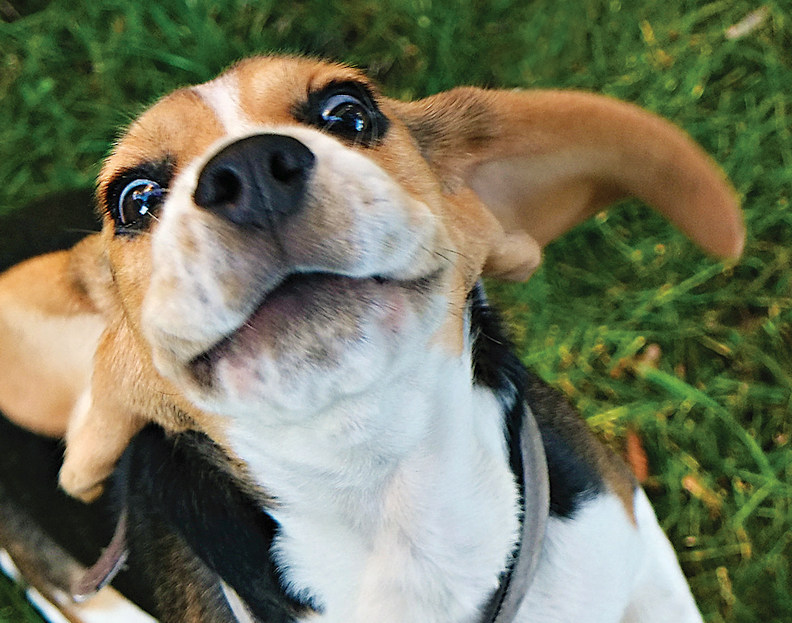
All dogs, big or tall, large or small, share the most mystifying of all of the senses, the sense of smell. Science has uncovered some amazing facts about the sweet wet appendage at the end of that adorable snout that just may astound you.
There are many reasons dog noses are so very special. We have dogs that find cancers, drugs, explosives, firearms, wildlife, cadavers, lost people, and even bedbugs! They do it all with their amazing sense of smell.
Researchers from the Sensory Research Institute at Florida State University say a dog’s sense of smell is as much as 10,000 to 100,000 times as acute as a human.
James Walker, former director of the institute used this comparison to describe just how powerful a dog nose is. “If you make the analogy to vision, what you and I can see at a third of a mile, a dog could see more than 3,000 miles away and still see as well.”
But how do they do it? First of all, dog noses function quite differently than our own. When we inhale, we smell and breathe through the same airway. When dogs inhale, a fold of tissue just inside their nostril helps to separate these two functions.
We also can’t wiggle our nostrils independently, but dogs can. This helps them determine which nostril an odor arrived in and aids a dog in locating the source of a smell.
Who hasn’t witnessed a dog focused on an interesting scent, weave back and forth across that invisible trail? A dog’s nostrils are movable and can expand on inspiration and can also contract to prevent sniffing any unwanted objects. A dog can voluntarily exhale air out the side of his nostril so that his expiration doesn’t interfere with the odor molecules still in the air or on the ground.
When we exhale through our nose, we send air out the way it came in, forcing out any incoming odors. When dogs exhale, air exits through the slits in the sides of their noses. This extra nostril function enables dogs to be able to sniff continuously.
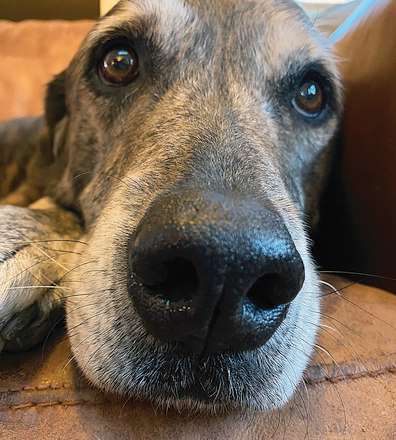
In a study done at the University of Oslo in Norway, a hunting dog holding its head high into the wind while in search of game sniffed in a continuous stream of air for up to 40 seconds, spanning at least 30 respiratory cycles!
In addition, when we inhale, we smell and breathe through the same airway. When a dog inhales, a fold of tissue just inside their nostril helps them to separate these two functions.
“We found that when airflow enters the nose it splits into two different flow paths, one for olfaction (smell) and one for respiration,” says Brent Craven, a bioengineer at Pennsylvania State University.
Craven modeled airflow and odor transport using high-resolution MRI scans of a lab cadaver’s nose. He and his colleagues are working to reverse-engineer the canine nose, in part to aid in the design of artificial noses that can sniff out odors as well as man’s best friend can. Perhaps someday we will have Robodors? Or how about Scentinators?
But wait, there’s much more to the nose story! A dog’s unique nasal anatomy and some pretty fancy nostrils are only just a part of what allows them to detect and identify an odor from just a few scant molecules.
Dogs (and cats) have a second scent organ and additional olfactory capability that we mere humans do not. It’s made possible by an organ called the vomeronasal organ, or Jacobson’s organ. Located in the bottom of a dog’s nasal passage, the Jacobson’s organ picks up the scent of pheromones. Pheromones are the chemicals unique to each animal that inform the sniffer of mating readiness and other sex-related details.
The pheromone molecules that this organ detects doesn’t get mixed up with other odor molecules because the Jacobson’s organ has its own nerves leading to a part of the brain devoted entirely to interpreting sexy signals.
Wowie-Kazowie! Pretty impressive sniffers so far, don’t you think?
Past the nostrils, a dog’s nose consists of a bony nasal cavity that is divided into two separate chambers. One contains the turbinate bones, the other, the paranasal sinuses.
The turbinate bones form a dazzling maze and is made up of scrolls of moveable cartilage and bony tissue lined with specialized ciliated sensory cells.
The ciliated cells are like fine hairs. When a dog sniffs, he inhales the scented molecules into his nasal cavities, where they are trapped in mucus within the turbinate bones and are processed by those ciliated cells. Once the cells have trapped the smell, they deliver their message to an organ in the brain called the olfactory bulb.
The scents processed in the olfactory bulb are then transported to the frontal cortex of the brain for recognition and to other regions of a dog’s brain that include the center for emotion, memory, and pleasure.
It’s no wonder dogs seem so happy rolling in stinky things! Researchers believe that there are so many interconnections devoted to scent within a dog’s brain that a simple scent detected by a dog has an entire set of meanings, memories, and emotional ties that only that dog knows and can interpret.
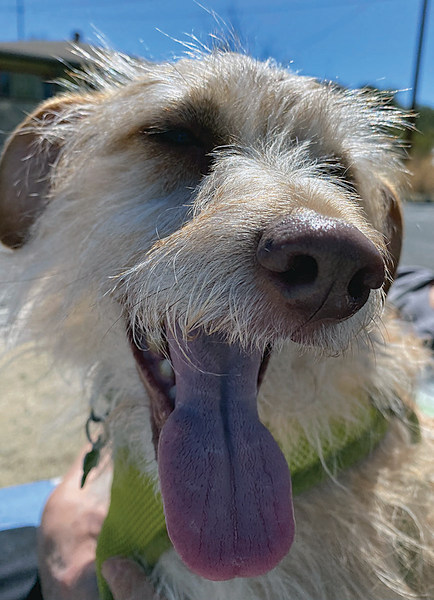
Some researchers estimate that one-third of the dog’s brain is allocated to the simple task of smelling. All this adds up to a canine nose that has thousands to millions of times the ability of his human companion.
You know what else do dogs have up their nose that we don’t? Only about three hundred million olfactory (scent) receptors, compared to about a measly six million in ours. And the part of a dog’s brain that is devoted to analyzing smells is, proportionally speaking, 40 times greater than ours.
In a human, the sense of smell is relegated to just a small region on the roof of our nasal cavity, along the main airflow path. So, the air we smell just goes in and out with the air we breathe.
In dogs, about 12 percent of the inspired air detours into a recessed area in the back of the nose that is dedicated to olfaction (the sense of smell), while the rest of the incoming air sweeps past that nook and disappears down through the pharynx to the lungs. Within the recessed area, the odor-laden air filters through that labyrinth of scroll-like bony structures, the turbinates.
The turbinates sieve the odor molecules based on their different chemical properties. Olfactory receptors (remember 300 million of them?) reside within the tissue that lines the turbinates. The receptors recognize odor molecules by their shape and then dispatch electrical signals to the brain for analysis.
We all know that we have the ability to use a dog’s incredible sense of smell to benefit mankind in ways we are only beginning to imagine. Today our working scent dogs involved in search and rescue have been known to follow a trail that is more than a week old!
Searching for cadavers is certainly not a pleasant task for any being, but we have dogs that have detected drowned people in over 80 feet of water. We have canines used for detecting explosives, firearms, and drugs, and even scenting tumors in human patients.
Science has even begun to use dogs to smell the breath of humans to help diagnose internal diseases before they become symptomatic.
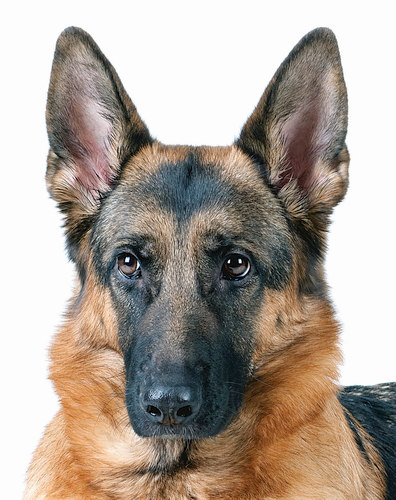
Do you think your dog may have the right “snuff” to be a scent dog? According to the American Kennel Club any dog can be scent trained. But, not every dog has what it takes to be a Working Detection Dog. These dogs are specifically trained for police and service work. They include Standard Explosive Detection Dogs, Body-worn / Camera Explosives and Combat Explosive Detection.
There are Narcotic Detection Dogs, Currency Detection Dogs, and Search and Rescue Dogs. We also have Security Patrol Dogs, Special Responsive SWAT team dogs, Tracker Dogs for Human Scent, and Anti-poaching Dogs.
Breed is important for these highly specialized trainings as well. For example, German Shepherds are known as the world’s leading police and military dogs. They work tirelessly in search and rescue and narcotics detection due to their keen sense of smell.
The Belgian Malinois is a popular military working dog that uses its keen nose to detect explosives. Labrador Retrievers excel at all types of detection work because of their wonderful noses. They are widely used as Search and Rescue dogs, and have even been trained to sniff out cancer from patients’ breath.
Who is the champion of all the sniffers? That award goes to the Bloodhound. The Bloodhound is one of the oldest dogs that hunt by scent. Its work with law enforcement has been so accurate that evidence trailed by a Bloodhound has been accepted in courts of law.
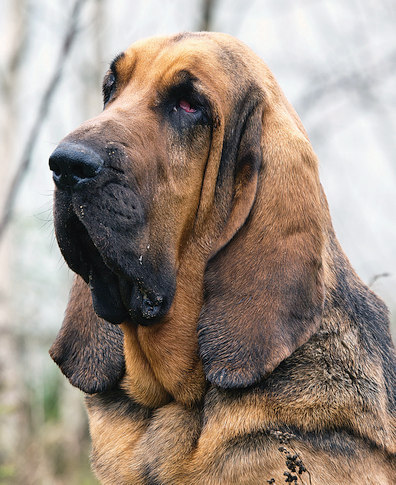
A bloodhound’s appearance actually adds to its tracking ability. The loose, wrinkled skin around their face helps trap the scent particles and their long, droopy ears drag on the ground and collect odors by sweeping them around their nostrils.
But any dog, big or small, large or tall can be scent trained. If you are interested in learning if your dog is “up to snuff” check out the American Kennel Clubs website. AKC.org for tips to get started and help discover online scent training lessons you can do at home.
And the next time that delightful wet nose nuzzles you, you should pause and marvel at that truly amazing super hero of scent. And then give that sweet nose a kiss in appreciation for that wonderful gift of nature and all the amazing things that glorious nose does for us mere humans.

